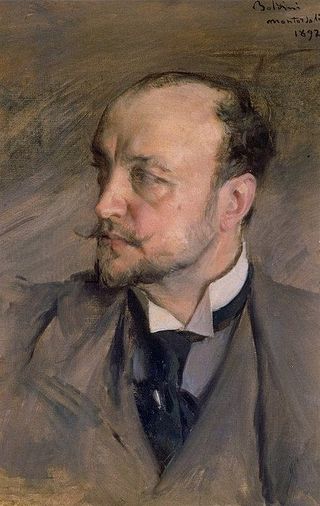Related Research Articles

Giovanni Boldini was an Italian genre and portrait painter who lived and worked in Paris for most of his career. According to a 1933 article in Time magazine, he was known as the "Master of Swish" because of his flowing style of painting.

Telemaco Signorini was an Italian artist who belonged to the group known as the Macchiaioli.

Luigi De Giudici was an Italian painter of the Venetian anti-academic movement in the first years of the twentieth century. His works were exhibited at Ca' Pesaro between 1912 and 1920 and at the International Exposition of Paris (1937).

Francesco Menzio was an Italian painter.

Plinio Nomellini (1866–1943) was an Italian painter.

Francesco Paolo Michetti was an Italian painter known especially for his genre works.
Cesare Bertolla was an Italian painter, described as specializing in the painting of landscapes with animals and figures from the marshy and malarial (Paludi) regions, painting in areas around Rome.
Luigi Steffani (1828–1898) was an Italian painter, mainly of sea- and landscapes.
Carlo Stratta was an Italian painter.
Attilio Stefanori (1860–1911) was an Italian painter, mainly working in watercolors and acquaforte etchings. He painted both landscapes, historic, and religious paintings.

Pietro Sassi was an Italian painter.

Ulvi Liegi was an Italian painter and printmaker. Part of the Post-macchiaioli movement, he painted various cityscapes of Livorno and depictions of Livornese daily life.
Francesco Scarpinato was an Italian painter.

Alfredo Luxoro (1859–1918) was an Italian painter, mainly of landscapes, genre, and orientalist themes.
Enrico Reycend was an Italian painter, mainly of landscapes and vedute.
Raffaele Armando Califano Mundo was an Italian painter.
Rinaldo Saporiti was an Italian painter.
Salvatore Marchesi was an Italian painter, mainly painting interior scenes of churches. A roughly contemporary Salvatore Marchesi was a prominent Sicilian baritone.
Edoardo Raimondi was an Italian painter, known for landscapes and genre subjects.
Marcello Baschenis was an Italian painter.
References
- ↑ Istituto Matteucci Biography.
- ↑ Dizionario degli Artisti Italiani Viventi: pittori, scultori, e Architetti., by Angelo de Gubernatis. Tipe dei Successori Le Monnier, 1889, page 84.